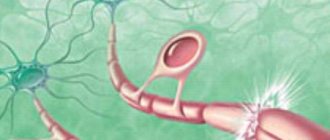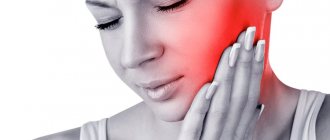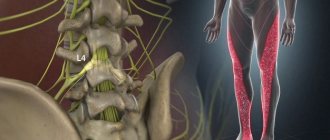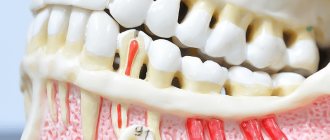What is the trigeminal nerve
The human face has many muscles and nerve endings. Not only the mucous membranes of the nose, pharynx, and conjunctiva, but also the nerve endings can become inflamed. This is most often associated with neurological disorders that change the sensitivity of the fibers that conduct impulses.
With neuropathy of the facial area, acute shooting pain occurs on the right or left. Mirror inflammation of the trigeminal nerve is extremely rare. It is located in the temporal region, near the base of the auricle. And from it there are branches along the entire half of the face:
- jaw nerve (upper and lower);
- optic nerve;
- infraorbital nerve.
The trigeminal nerve passes through the bone tissue in several places, which plays an important role in the occurrence of inflammation associated with pinching. Thus, inflammation of the trigeminal nerve can result in acute pain both in the upper and lower jaw, and in the forehead area, covering the eye sockets.
Location of the sciatic nerve
This nerve begins in the pelvis, in the lumbar spine. It is very long, due to which it covers a large proportion of the lower parts of the body. From the sacrum its branch exits through the infrapiriform foramen into the pelvis. Then it goes under the gluteal muscle, and is further divided into smaller parts that penetrate the muscles of the buttocks and thighs. The sciatic nerve simultaneously affects each joint of those located in this area.
The sciatic nerve provides sensation to the lower extremities
Descending to the popliteal fossa, it diverges into two branches: the tibial and fibular branches. Without these very branches of the nerve, not a single area of the skin of the legs would have sensitivity. Also, without it, the sensitivity of the muscles and joints of the legs is unthinkable.
Causes of inflammation of the trigeminal nerve
There are several reasons leading to inflammation of the nerve ducts:
- Poor blood supply associated with physical compression of the nerve. First of all, this is swelling caused by diseases of the ENT organs. The resulting tumor can also pinch the nerves.
- Inflammation associated with dentistry. This includes gingivitis, periodontitis, caries, pulpitis, and eruption of wisdom teeth. Each of these diseases can lead to suppuration, abscesses, swelling and bacterial infections of tissues.
- Medical error by an anesthesiologist - if the injection was given unsuccessfully and the needle got into a nerve, pain cannot be avoided.
- Hypothermia causes muscles to lose their elasticity, which leads to pinching of the nerves passing between the fibers.
- Bacterial infections, in particular tetanus and polio.
- The cause of inflammation of the trigeminal nerve, which is difficult to diagnose, is the psychological state of a person - frequent experiences, stress, and nervous disorders.
To determine the cause of inflammation, you need to consult a specialist.
Pinching symptoms
Doctors consider several syndromes that indicate that the patient has a pinched nerve.
- Lesera – straight leg does not rise;
- Sikara – pain intensifies if a person bends the foot;
- landing - it is impossible to take a sitting position yourself.
It hurts to walk and squat, but if you lie down or sit with your legs spread wide apart, it goes away. Signs of inflammation and pinching of the sciatic nerve are quite expressive, but they can still be confused with other diseases:
- spondylitis;
- myeloma;
- ankylosing spondylitis;
- phlebothrombosis;
- arterial insufficiency.
Treatment methods
Depending on what caused the inflammation, a course of treatment is prescribed. For bacterial lesions, the emphasis is on antibacterial therapy through systemic administration of drugs.
However, regardless of the reasons, the doctor prescribes painkillers to relieve pain and reduce inflammation. It could be:
- ibuprofen;
- paracetamol;
- analgin;
- ketorol;
- diclofenac.
All of the listed drugs can be prescribed either in the form of tablets for oral administration, or prescribed in the form of solutions for intramuscular administration.
When conservative methods are not possible, the help of a surgeon may be needed. This primarily concerns abscesses due to the eruption of wisdom teeth, pulpitis or other dental diseases. In this case, the abscess will be opened, pus will be removed, the wound will be treated with antiseptic, and the tooth will be removed, if necessary. If a pinched nerve occurs as a result of pathologies in the structure of the skull, the surgeon will perform an operation to correct the situation and free the nerve bundles.
As a complex therapy, massage, heating or exposure to a magnetic field and electric current can be prescribed. You cannot massage or warm the inflamed area yourself, because this can lead to complications associated with rupture of the purulent capsule, blood poisoning and paralysis of the facial nerve.
Separately, you may need to consult a neurologist who will determine the cause of the inflammation if other specialists have not found obvious foci of infection and abscesses.
Traditional methods of treatment are permissible only as an addition to the main therapy. For example, rinsing with chamomile decoction will relieve inflammation and reduce swelling. But you can resort to such procedures only with the permission of the attending physician.
Why does sciatica begin to develop?
Inflammation of this nerve may well be caused by the following factors:
- uncomfortable ambient temperature;
- stressful situations;
- pathologies of the spine, due to which the nerve can become inflamed or pinched;
- spinal injuries;
- diabetes;
- infections;
- lifting too heavy loads;
- lack of physical activity;
- pregnancy;
- drinking alcohol;
- poisoning with any heavy metal;
- gout.
There are many reasons for inflammation of the sciatic nerve
Moreover, sciatica does not necessarily begin because of just one single factor.
There are professions in which the likelihood of getting this pathology is slightly higher than in other jobs. Eg:
- farmer;
- machine operator;
- driver.
It is also exceeded among those whose workplace is not comfortable enough, as well as among smokers.
Also, sciatica can either appear suddenly, for example, due to an injury, or develop gradually, which results from difficult work and/or complications from other pathologies.
Possible complications
Doctors call facial paralysis the first complication that appears in the absence of adequate treatment. This means that a person who does not receive medical care in a timely manner is deprived of the opportunity to express his emotions through facial expressions on one side of his face. This condition can no longer be corrected, which will certainly affect the quality of life. Distortion of facial expressions will lead to the development of depression and constant dissatisfaction with one’s appearance. Not every patient can come to terms with irreversible changes in their appearance without deep distress.
One of the most unpleasant manifestations of paralysis is the inability to close the eyelids on the injured side of the face. In this case, the eye will have to be regularly instilled with artificial tears to prevent the cornea from drying out, since natural hydration through blinking becomes unavailable for this eye.
How to suspect the onset of sciatica?
Once sciatica has begun, it is impossible not to pay attention to it. Here is a list of sciatica symptoms:
- pain in the gluteal muscle and back of the leg. Usually the sensation is bilateral, but is more noticeable on the affected side;
- the pain moves from top to bottom, and the buttocks, hips, lower legs, and lower back begin to ache;
- difficulties in straightening up, and it is most difficult to do this by bending forward: in this position the pain is weaker;
- attempting to turn increases pain;
- inability to lean on the leg where the sciatica occurred due to acute pain when trying to do so;
- it happens that a person suffers from fecal or urinary incontinence;
- the temperature usually rises, but it does not become higher than 38. Along with this, spasms and muscle pain occur;
- redness and swelling of the skin along the affected nerve;
- muscles may atrophy/weaken slowly.
Inflammation of the sciatic nerve is accompanied by numerous symptoms that clearly indicate the pathology itself
The patient needs urgent consultation in the following cases:
- increased body temperature up to 38 degrees in combination with pain;
- red/swollen back;
- pain gradually spreading to new areas;
- numbness in the pelvis, hips and legs, so strong that walking becomes worse;
- burning when relieving minor needs, it is more difficult to retain feces than usual.
Prevention of inflammation
To prevent the risk of developing inflammation of the trigeminal nerve, it is recommended to follow a number of measures:
- monitor oral hygiene and consult a dentist in a timely manner;
- do not stay in the cold for a long time or protect your face from freezing with a scarf;
- do not self-medicate otitis media.
At the first manifestations of pain on the face, you should immediately consult a doctor. This will stop the development of inflammation. In addition, early diagnosis allows for conservative treatment methods.
Sciatica therapy
When treating sciatica, medicinal and non-medicinal methods can be used. How it is carried out is determined by the degree of pathology, as well as the original cause - that is, the nerve is inflamed or pinched. If necessary, doctors may resort to surgery. But the operation is performed only as a last resort, when other methods of combating the disease have been found to be unsuccessful.
Here is a list of non-drug treatments for sciatica:
- physiotherapy;
- hydrotherapy;
- massage;
- exercise therapy;
- visiting the gym.
There are many methods for treating sciatica
There are also non-traditional, but still effective therapeutic methods:
- acupressure;
- ozone therapy;
- manual therapy;
- mud therapy;
- cupping massage;
- acupuncture therapy;
- leech treatment.
Drug treatment methods for sciatica
When treating sciatica, the main focus is on medication. Let's talk about the main groups of medications that are used to cure sciatica.
Despite the fact that the purposes of using glucocorticosteroids coincide with NSAIDs, the methods of their use are quite different. Any steroids should only be used to relieve symptoms if carefully supervised by a specialist. As well as using any narcotic drugs designed to relieve pain, for example, morphine and tramadol.
Sometimes the patient is prescribed medications belonging to different categories.
Typically, topical medications are used, produced in the form of ointments and creams. There are also vitamins and medications for pain and inflammation that can be used in the form of inhalations or injections during exacerbations and/or severe pain.
The patient may be prescribed NSAIDs
If you need medication in tablet form, it is recommended that you first consult a specialist. There are quite a few NSAIDs whose side effects override their beneficial effects or at least make them less attractive from this point of view. For example, some tablets disrupt the gastrointestinal tract and also cause bleeding and ulcers. Moreover, the risk is greatest when using such products for a long time. So NSAIDs are used only during exacerbations, which require effective pain relief techniques. Tablets should not be taken for more than 5-14 days, which is determined by the drug itself.
Symptoms of optic neuritis
Symptoms vary depending on the type of disease: intrabulbar (papillitis) or retrobulbar neuritis.
Papillitis (intraocular, retrobulbar neuritis)
It is characterized by an acute onset with a rapid deterioration in visual acuity - from 1-2 hours to 1-2 days. In some cases, mild headache and pain when moving the eyes occur. With partial damage, visual acuity may be preserved, but scotomas appear - areas of partial or complete loss of the visual field, which can be central or paracentral, round or arch-like. There may be a narrowing of the boundaries of the visual field, a decrease in dark adaptation and color perception. Most often, symptoms of visual impairment disappear after 7-10 days; after 2-3 weeks (sometimes up to 5 weeks), vision is restored. Without treatment or with severe neuritis, optic nerve atrophy with complete loss of vision is possible.
Retrobulbar neuritis
It occurs in acute or chronic form. The acute form is more often characteristic of unilateral lesions, the chronic form - for bilateral ones.
General symptoms:
- pain when moving the eyeballs and pressing on the eye;
- color vision disorders - decreased sensitivity of the eye to colors, shades quickly fade;
- a drop in visual acuity to the point of complete inability to distinguish objects;
- appearance of scotomas.
Depending on the form of retrobulbar neuritis, symptoms may vary. Axial neuritis is characterized by a combination of central scotoma with partial loss of visual fields and the appearance of peripheral defects in the visual field. In the peripheral form, the field of vision narrows along the entire perimeter - it is concentric in nature. The transversal form is characterized by a significant decrease in vision, up to blindness, scotomas merging with peripheral loss of visual fields.
Treatment of optic neuritis
Treatment must be carried out in a hospital setting; it should begin as early as possible, in order to avoid the disease becoming chronic and developing complications. Source: Modern view on the problem of optic neuritis (systematic review). Krivosheeva M.S., Ioileva E.E. Saratov Scientific and Medical Journal, 2022. p. 602-605. For patients with optic neuritis, diet No. 15 is indicated - a general table, in the absence of indications for other types of therapeutic diets.
The basis of treatment is etiotropic therapy aimed at eliminating the primary disease that caused optic neuritis. Until the etiology of the disease is clarified, remedies are used to reduce the symptoms of inflammation, remove swelling, allergic manifestations, and improve metabolism. For this purpose:
- glucocorticosteroid drugs, if they are intolerant - non-steroidal anti-inflammatory drugs (prescribed in rare cases);
- antibacterial or antiviral therapy;
- antifungal agents to prevent fungal infection due to a long course of antibiotics;
- detoxification therapy – intravenous drip administration of saline solutions;
- antihistamines;
- diuretics;
- products that improve microcirculation;
- neuroprotectors;
- vitamins.
In addition to medications, physical therapy may be used to treat optic neuritis.
With papillitis, as well as the infectious-toxic etiology of the disease, the prognosis is more favorable than with other types of optic neuritis - in 75-90% of cases, with proper treatment, vision is completely restored. When the optic nerve is damaged due to autoimmune, demyelinating diseases, collagenosis, sarcoidosis, and specific infections, relapses often occur, incomplete restoration of vision, and nerve atrophy is possible. Source: Results of treatment of optic neuritis. Latypova E.A. Saratov Scientific and Medical Journal, 2022. p. 875-879.
Occipital neuralgia
The article was prepared by a neurologist, the chief physician of our clinic, Pavel Dmitrievich Kovzelev. In this article, in addition to a description of occipital neuralgia and the principles of treatment, you can watch a video with a clinical case from our patient, as well as a video of how an occipital nerve block is performed - one of the most effective methods of treating this pathology.
Anatomy of nerves.
The occipital nerves, 3 in number, are formed at the level of the 2-3 cervical vertebrae, then exit to the posterior surface of the spine and are located between the deep and superficial muscles of the neck.
At the level of the occipital bone, the nerves pierce the superficial muscles and exit under the skin, breaking up into small terminal branches that innervate the skin of the occipital region.
It's best to look at the picture.
Causes of neuralgia/neuropathy of the occipital nerve.
Why occipital neuralgia (also known as neuropathy) occurs is not completely clear.
The most popular hypothesis is that the nerve becomes trapped between the muscle and the fibrous tissue at the exit site and is pinched.
In people who have undergone surgery on the cervical/occipital region, people with Arnold-Chiari malformation, problems in the cervical spine, as well as those who have recently suffered a whiplash injury to the neck, NLDs are more common, which, in principle, fits into the “trap” hypothesis.
Symptoms of occipital neuralgia.
- The pain is severe, shooting, like electric shocks.
- Has a paroxysmal character: from several seconds to several minutes.
— The pain is localized in the back of the head, usually on one side and rarely on both sides.
- Between attacks, a dull, low-intensity pain may persist.
An attack can be provoked by touching certain points of the head, turning the head and any mechanical stimuli.
Sometimes patients note a decrease in sensitivity in these areas, and sometimes patients note dizziness and nausea.
IMPORTANT: Pain with occipital neuralgia can reach the fronto-ocular region through the connections of the occipital nerve with the trigeminal nerve at the level of the spinal cord.
The clinical picture may vary among patients. There are diagnostic criteria that I took from the 3rd International Classification of Headaches.
Let's look at them, but they are more important to me or your doctor.
- Unilateral or bilateral pain in the distribution of the greater, lesser and/or third occipital nerves and fulfillment of BD criteria
- Pain has at least two of the following three characteristics:
- repeated paroxysmal attacks lasting from several seconds to minutes
- heavy in intensity
- shooting, stabbing, or sharp pain
- Pain is associated with both of the following:
- dysesthesia and/or allodynia, manifested during painless stimulation of the scalp and/or hair (this is when normal touch is perceived as painful)
- one or both of the following: a) tenderness when pressing over the affected nerve branches
- b) trigger points at the origin of the greater occipital nerve or in the distribution of the C2 root.
- Pain is temporarily reduced by applying local anesthesia to the affected nerves. (i.e. when performing a blockade).
- Does not fit other diagnoses of the 3rd International Classification of Headaches.
Diagnosis of neuropathy of the occipital nerves. The diagnosis of NMN is made clinically (i.e., upon examination by a doctor), but for this it is necessary to exclude other causes. Taking into account the fact that many pathological processes in the posterior part of the brain and skull, as well as in the cervical spine, can produce similar pain in the occipital region, it is necessary to carry out:
- MRI of the brain
- MRI of the cervical spine, ultrasound examination of the vertebral arteries.
- In our clinic, ultrasound of the vessels of the head and neck is performed by a doctor with extensive experience, Irina Alekseevna Romadova, using an expert-level ultrasound device.
Treatment of neuralgia of the occipital nerves Treatment usually begins with a diagnostic blockade, which often gives a lasting positive result. I prefer to perform this block under ultrasound guidance for more precise and, more importantly, safe insertion. If necessary, the blockade can be repeated, but not more than once every three months. This is what it looks like schematically
This is how everything is visible with ultrasound navigation. I circled the nerve itself and its signature in red. It is very small, it literally looks like a dot. (Image clickable)
Drug therapy (standard drugs for neuropathic pain): gabapentin, tricyclic antidepressants, pregabalin, baclofen, carbamazepine.
of reflexology has proven itself well , which in this case is additional to stabilize and consolidate the effect.
If all of the above methods do not help, then you can: try botulinum toxin.
Also, one of my patients noted the effect of using Cefaly , a device for the treatment of migraines, which can be rented at our clinic to evaluate its effectiveness.
Neuralgia of the occipital nerves is an uncommon but extremely painful pathology. Sometimes people suffer for decades without a diagnosis or adequate treatment. At the same time, neuralgia has relatively clear diagnostic criteria and treatment approaches.
Kovzelev Pavel Dmitrievich
Chief physician, neurologist, vertebrologist











